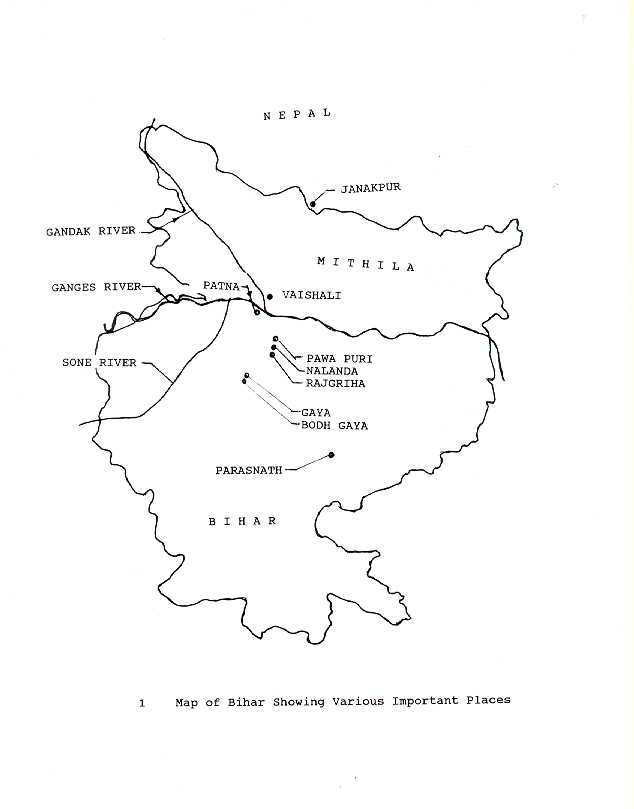There exists a land on both sides of the river Ganges in India which occupies the same place for people believing in Eastern Religions as does Jerusalem and the neighbouring areas for the people belonging to Christianity, Islam and Judaism. Great philosophers, sages, kings, and the knowers of Truth lived here. The word `Bihar' is a distortion of the word `Vihar' from Sanskrit, which means, ( a ) wander, and ( b ) a Buddhist monastery. Both these meanings are appropriate because ( a ) Lord Mahavira and many other Jain Tirthankars, and also Lord Buddha, wandered around in this land, and ( b ) It had numerous Buddhist monasteries and was the Centre of Buddhism .
The messages these people left for the rest of the world took forms of different Eastern Religions called Hinduism, Buddhism, Jainism and Sikhism. The scriptures that millions and millions of people read contain the same Truth but, because of the various limitations of different people, the same Truth appears differently to them. This land is called Bihar which is one of the states of India.
Hinduism as it is known these days, was known as the Sanatana Dharma which actually means that this religion has always existed



even since the creation. According to this religion, the creation and destruction of the universe is a cyclic process and one cycle is called the Kalpa. One day and one night of Brahmadeva ( faculty of God responsible for the creation ) is equal to one Kalpa which is also equal to 2 x 4,320,000,000 human years. In other words, one cycle is equal to 8.64 billion years. During this cycle, all the perceptible things in the universe are created and destroyed by the Imperceptible.
Every Hindu knows about King Janaka ( of the Upanishads ) and his daughter, Devi Sita from the famous epic called the Ramayana. He was the king of Mithila (North Bihar) and was a great Karma Yogi himself. Yajnavaalkya rishi, a scholar of Advait philosophy, was in his court. So was Gargi, a woman, knowledgeable in the Vedas and other scriptures. The discussions between the Yajnavaalkya rishi and his wife, Maitreyi are very famous amongst the Hindu philosophers. The question of the woman's emancipation did not exist in those days because everyone performed their duties sincerely. There were no artificial barriers. The practice of veil over a woman's face was not the ancient Indian culture or tradition. It came to be practised only in the Northern India after the contact with the Islamic culture.
Jainism had its peak in Bihar. Mahavira was the 24th Tirthankara who was a contemporary of Lord Buddha. Lord Mahavira was like a prince in Vaishali. They practised democracy in this place which was the earliest practised democracy anywhere in the world. The cities were well planned and the administration was run very smoothly. Twenty other Tirthankars obtained nirvana on the top of the hills at Parasnath (Shikharjee) in Bihar.
The Buddhists have their most sacred place at Bodh Gaya where Lord Buddha got enlightenment under a tree. The other places where he visited were Rajgriha (Rajgir), Pataliputra, and Vaishali among the well known in Bihar. He gave his first sermon at Sarnath near Varanasi in the neighbouring state Uttar Pradesh.
The Sikhism had its beginning in the fifteenth century. The first guru was Guru Nanak who was born during the Bhakti period of the Hinduism. He travelled far and wide and his experiences were based on both Hinduism and Islam. His teachings were from ancient Hindu scriptures such as the Vedas. He believed in non-violence. This religion was given the modern look by the tenth guru, Guru Gobind Singh who was born at Patna in Bihar. He spent early part of his childhood there. He did resort to violence to seek justice which itself was preached by Lord Krishna in the Hindu scripture called the Gita. This guru had himself composed poems on Lord Krishna.
In this book, the philosophies of these Eastern Religions is discussed along with a brief description of places of importance . Subsequently, the relationship between the Hinduism, Buddhism and Christianity is discussed. Finally, the exemplary life ofthe Dalai Lama of Tibet, who is one of the Nobel Peace Prize winners, is also mentioned along with the Buddhism.